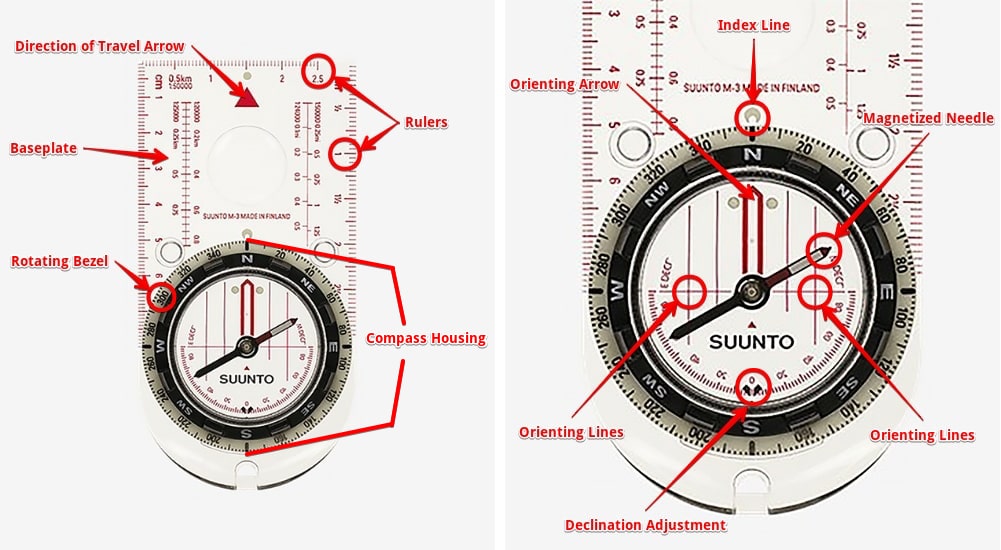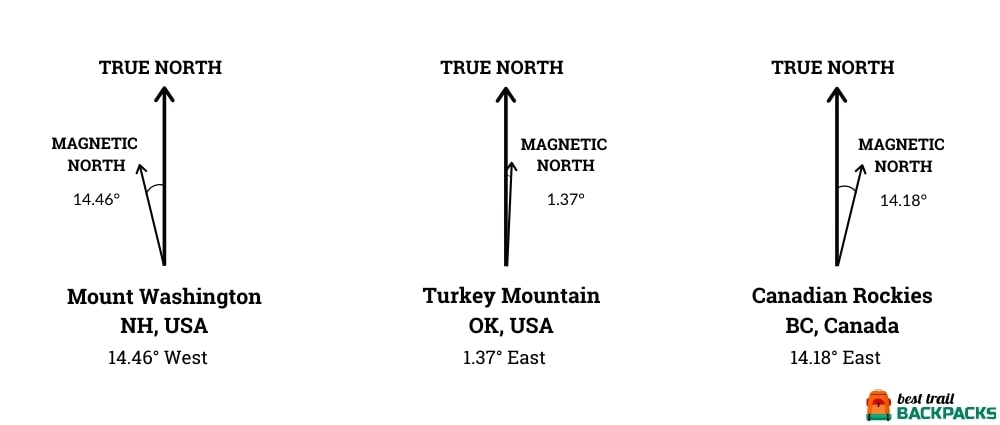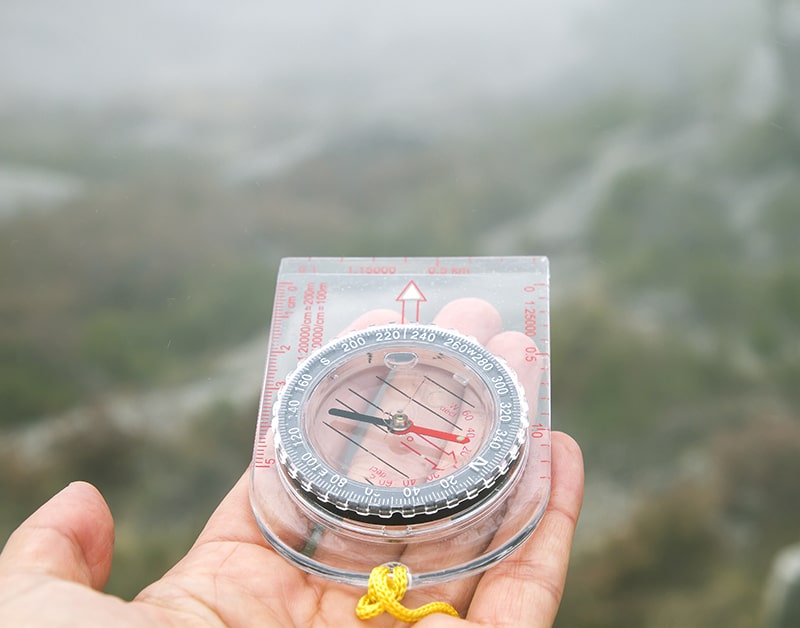When going on a hiking trip, there are a few items that you must pack in your backpack, no matter if you are a seasoned or novice hiker, and they include a compass and a map. To help learn the basics, I put together this step-by-step guide showing you how to use a compass when hiking so that you can safely return home to your loved ones.
Nowadays, technology is everywhere. Many of you reading this post are wondering why do I need to learn to navigate with a compass. I can use a GPS device or my smartphone to navigate throughout the wilderness or the trails.
Even with the GPS in your phone or a hiking GPS device, you still need to learn how to use a conventional compass. Why? Because these electronic gadgets run on batteries that might give out or you might end up in remote places where there is no signal, so your GPS becomes useless.
You need to have a backup plan! Learning to navigate is an invaluable survival skill to have for any avid hiker, or outdoor enthusiast.
So, without further ado, let’s take a look at the different kinds and parts of a compass:
Types of Compasses:
There are 2 main types of compasses available on the market:
- Gyrocompass: also known as a gyroscope, is mainly used on moving platforms such as ships and airplanes. It has a spinning wheel in which rotation is driven by the rotation of the earth and is not affected by magnetic fields.
- Magnetic Compass: There are many types of magnetic compasses. However, the baseplate compass, also known as the orienteering or mountaineering compass, is best suited for hiking excursions.
Because the magnetic field strength varies along the North and South poles, compass manufacturers have developed balanced zone compasses by adding weight to the end of the magnetized needle to compensate for the natural tilt of the magnetic field, and this is referred to as magnetic zone balancing.
The earth is divided into three zones: The Northern hemisphere (magnetic North), the Southern hemisphere (magnetic South), and a Global or universal zone.
It is paramount always to use a compass made for the region where you are planning to hike. Thus, a compass manufactured for the Northern hemisphere (NH) should not be used in the Southern hemisphere (SH). Why? Because the needle is not correctly balanced for usage in the southern hemisphere and will hit the lid resulting in an inaccurate reading.
If you are planning to use your magnetic compass to go hiking all over the world, you should opt for a Global balanced compass.
Anatomy of the Baseplate Compass:

- Baseplate: It’s the transparent flat surface of your hiking compass to which everything is attached to. It has a rectangular shape and usually has at least one straight side edge, enabling it to draw lines on a map.
- Compass Housing: It’s the round plastic bubble that housed a magnetized needle in a liquid, usually, alcohol.
- Rulers: They are located along the edges and allow you to measure distances.
- Direction-of-Travel Arrow: This is the arrow on the baseplate, which indicates the direction to point the compass when taking or following a bearing.
- Rotating Bezel: Often called the “azimuth ring,” this is the rotating outer circle marked in degrees (0-360) along with cardinal points (N, NE, E, SE, S, SW, W, NW).
- Index Line: It’s located above the rotating bezel and used for taking a bearing reading.
- Magnetized Needle: It’s usually red or white, and it points to the magnetic north pole.
- Orienting Arrow: Inside the compass housing and used to align rotating bezel when taking a bearing.
- Orienting Lines: Parallel lines inside the housing of the hiking compass that rotates with the rotating bezel and use to align with the north-south grid lines on your map.
Common Lingo that Comes with a Compass
Before going into the thick of things and showing you the different ways you can use a compass on your hiking journey, there are a few terms that you need to master before being able to use a compass on the trails.
First, let’s talk about “a bearing.” What in the heck is a bearing when it comes to navigating with a compass? Well, simply put a bearing is a nice way to describe a direction of travel from your current position. It’s measured in degrees. It is the value given by the rotating bezel within the index line of your hiking compass.
Now, did you know that when it comes to navigating with a compass, there are two Norths? Yes indeed! There is the “True North” and the ”Magnetic North.”
The True North refers to the North pole, which is the point on a map where all the longitudinal lines intersect.
The Magnetic North is where the magnetized needle within your hiking compass points and is controlled by the earth’s magnetic field. As a result, the magnetic north varies depending on your location in the world and over time.
To adequately use your compass while hiking, you need to factor in the difference between the true north and the magnetic north. This is known as the magnetic variation or declination.
Magnetic variation or declination refers to the difference in degrees between the Magnetic North and the True North. This variation can be East or West from the True North.
Here is an example:
Let’s say that you want to go hiking on Mt Washington, NH, USA. Then the declination number will be 14.46 degrees West of the True North.
On the other hand, if you want to visit the Canadian Rockies, BC, Canada, then the declination number is 14.18 degrees East to the True North.
See the image below:

Therefore, on your hiking compass, you must enter the declination value to get the correct bearing. Many compasses allow you to correct the declination. To learn how to do this, consult your instruction manual.
If your baseplate compass doesn’t have the built-in declination adjustment feature, then you will have to manually add or subtract the declination number each time you are taking a new bearing lecture.
So, if you have an East declination, you will need to subtract the value, whereas, with a West declination, you’ll have to add that number to your bearing. If you don’t, you will not get to your destination.
Because if your bearing is off even by only 1 degree, that will set you off course by about 100 feet (30.5m) over 1 mile (0.6km), so you could get lost fast!
How do you find the declination number for where you plan to go hiking? There are two ways you can get this information.
- Legend of the Map: Check the legend of the map of the area where you are planning to go on a trek. Bear in mind that the declination changes not only with the location but also with time. If you have an old map, the value listed on the map might not be right.
- Online: To get an accurate declination number for your location, visit the National Oceanographic and Atmospheric Administration (NOAA) website.
Now that we are familiar with the different parts and the jargon related to a compass, let’s dig in.
When it comes to navigating the hiking trails or the wilderness with a compass, there are two ways to go about it. You can either take your bearing from a map or in the field.
How to Use a Compass with a Map:
Before using your baseplate compass with a map, you need to first orient your map by doing the following steps:
Orienting the map:
- Place your hiking compass on the map with the direction-of-travel arrow pointing toward the top of the map.
- Rotate the rotating bezel until the N aligns with the traveling arrow.
- Move the baseplate of the compass until the straight edge of the compass align with either the right or left side of the map.
- Keeping the map and the compass steady in your hands at chest height, turn your body until the magnetic needle aligns with the orienting arrow.
- Now, your map is oriented correctly and ready to be used with your compass for your hike.
Get a bearing from a map:
- If you know your location, then mark it as point A on the map. Look for your destination on the map, which will be point B.
- Place the compass on the map with one of the corners of the base plate’s straight edge on your current position (Point A). Align it to draw a line from your current location to your destination (Point B), having the direction-of-travel arrow pointing toward your destination.
- Rotate the rotating bezel until the orienting lines are aligned with the north-south grid line on the map.
- Read the bearing shown inside the index line.
- Take the compass in your palm with the direction-of-travel arrow pointing away from you at chest height and rotate your body until the magnetized needle falls into the orienting arrow.
- The direction-of-travel arrow is now showing the direction to take to reach your destination, well done!
How to Use a Compass in the Field
Now, let’s say that you are on the trail and want to know your exact location on the map. You can take a bearing in the field and transfer it to the map by doing the following steps:
- Find a landmark nearby that you can also find on the map, like, for instance, a mountain or a lake.
- Hold your hiking compass flat in your hand with the direction-of-travel arrow pointing toward the landmark.
- Turn the rotating bezel until the magnetized needle is aligned inside the orienting arrow.
- Read the bearing value within the index line.
- Now, place the compass on the map, and put one of the corners of the straight edge on your chosen landmark with the direction-of-travel arrow pointing toward your landmark.
- Keeping the direction-of-travel arrow pointing in the direction of your landmark, turn the whole baseplate of the compass to align the orienting lines parallel with the north-south grid lines along with N symbol on the rotating bezel pointing to the north on the map.
- Using the straight edge of your hiking compass, draw a line until it intersects with the trail. That corresponds to your position on the hiking trail.
If you are not on a trail but off the beaten path, you will repeat this process with at least two other landmarks.
This process is called triangulation. Often what you get is a triangle on the map, and your location is within this triangle.
If you chose good landmarks that are not too far away from your position and at least 60 degrees apart from each other, the chances are that you could end up with a point on the map, which corresponds to the intersection of the lines drawn and that is your location.
Watch the video below, showing you how to use a compass with a map and in the field:
Here are some fundamentals that you need to keep in mind while navigating with your compass on the trails or in the wilderness:
- If you are serious about hiking, you must sign up for compass navigation training. Don’t solely rely on the guide outline in this post; get more advanced training on how to use a compass.
- Practice using the compass in a parking lot or in a field to get the hang of it.
- Keep the compass level to avoid the tip of the needle touching the clear lid, resulting in inaccurate readings.

- Always hold the compass in the palm of your hand and in front of you at chest height.
- Alternatively, when using a compass with a map, lay the map on a flat non-metallic surface.
- The first rule of thumb when using a magnetic compass is to stay away from metallic sources. Don’t put your map on the hood of your car to get your bearings with the compass. Even belt buckles or the nails found on picnic tables can interfere with the readings.
- Be aware of the high-tension power lines; stay clear of those, and be at least 50 yards (150 feet or 45 meters) away when taking your bearing.
Final Thoughts
Here you have it, a step-by-step guide to safely navigate the trails or unknown territories and ensure that you don’t get lost while on a hiking excursion.
Even though we live in a technological era, learning how to use a hiking compass is a paramount survival skill to pack in your backpack. Because, gadgets such as hiking GPS or your smartphone equipped with a compass app are not fully proofed, as they rely on batteries, which could die out, plus the GPS signal can be sketchy in the wilderness.
Lastly, if you are thinking about making hiking part of your routine, you should sign up for a navigation training course to complement this guide.
If you have any questions about how to use a compass, please leave them below, and I will get back to you promptly.
Wow, there is so much I never knew about how to use a compass. I just thought that magnetic compasses always pointed north. It’s probably a good thing I haven’t gone on a long hike yet.
This post provides excellent information for anyone new to hiking like I am. Being that more people are starting to do more outdoor activities since the Covid-19 pandemic, I’m going to be passing on this information.
It just goes to show we can’t always rely on our smartphones.
Magnetic compasses always point North, but it’s the Magnetic North. If you don’t take into account the True North and apply the correction, which is the declination, then you won’t have an accurate bearing reading and most certainly be off-path or worst lost in the wilderness.
If you are new to hiking, here is a little piece of advice, don’t go hiking alone! Take a few minutes to read my post about finding a hiking partner, and don’t forget to pack a hiking compass and a map!
It seems some times that one has to go the through the unpleasant experience of getting lost to realize then that learning how to use a compass is an integral part of being a hiker.
I really appreciated learning how to obtain a bearing from a map. I’ll practice over the weekend how to take a bearing from the map as well as getting a bearing from the field and transfer it to a map. Thank you very much!
I am glad that you found value in my post on how to use a compass when hiking. Of course, getting lost on the trails is every hiker’s worst nightmare.